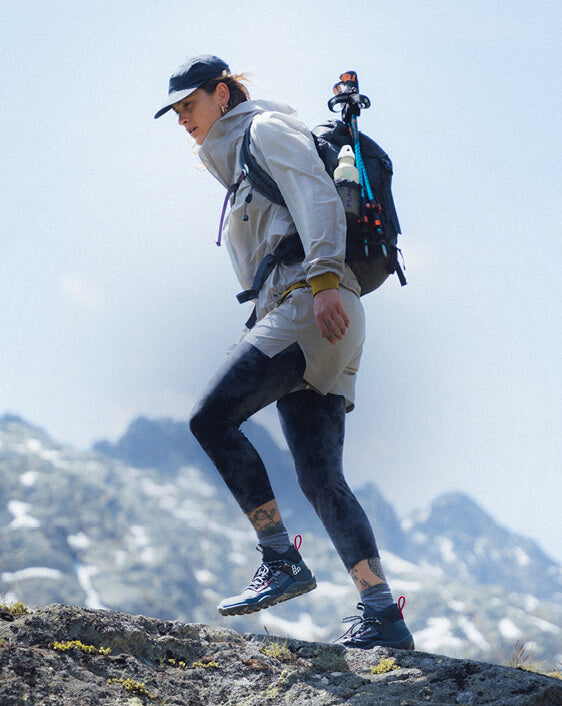How many times have you replaced your hiking boots? Or tossed away a camping tent because it got torn on your last adventure? Have you ever thought about the environmental impact of these actions? As outdoor enthusiasts, we cherish the natural world, so it's essential for us to adopt sustainable practices in all aspects of our lives, including the gear we use.
The concept of a circular economy is all about reducing, reusing, and recycling, aiming to eliminate waste and promote the continual use of resources. This philosophy can easily be applied to our camping and hiking gear. From considering the lifecycle of the gear we purchase to exploring repair, reuse, and recycling options, a circular economy approach can help us minimise our environmental impact and contribute to a more sustainable future.
So, if you're a hiker, camper, or just a lover of the great outdoors, and you're looking for ways to embrace sustainability, you're in the right place. We're going to delve into the principles of a circular economy and how they can be applied to your outdoor gear.
Responsible Gear Purchasing: Investing in Sustainable and Long-lasting Products
A Conscious Commencement: Choosing Quality and Sustainability for Your Gear Collection
Before embarking on any hiking or camping excursion, the foundation of your eco-friendly gear journey begins with selecting sustainable and high-quality products. Here's how to make responsible purchasing decisions:
- Research Brands and Materials: Investigate the sustainability initiatives and commitments of the brands you're considering, prioritising those with eco-conscious policies and materials in their product lines.
- Consider Durability: Opt for long-lasting equipment built to withstand the rigours of outdoor adventure, reducing the need for frequent gear replacements and minimising waste.
- Less is more: Shun the urge to over accumulate equipment, selecting only the essentials and investing in versatile gear that can serve multiple purposes during your hiking and camping trips.
Proper Maintenance and Care: Maximising the Life of Your Hiking and Camping Gear
Guardian of Your Gear: Extending Life through Careful Maintenance Practices
Timely maintenance and proper care of your hiking and camping equipment are critical in extending its life and performance. Practice these maintenance tips for eco-friendly gear stewardship:
- Cleaning and Storage: Regularly clean your gear as per manufacturer guidelines and store it in a cool, dry place to prevent mould and mildew growth, maintaining its quality for future adventures.
- Inspect and Repair: Inspect your gear for any wear or damages before and after each trip, ensuring timely repairs or part replacements to eliminate the need for whole product replacements.
- Seek Professional Help: If you're unsure of how to perform maintenance, consult the manufacturer or engage professional services to ensure the longevity and performance of your equipment.
Fix It, Don't Replace It: Understanding When Repairs Are Preferable to Replacement
Renewing Your Adventure Arsenal: Harnessing the Power of Gear Repairs
The phrase "if it ain't broke, don't fix it" might be familiar, but gear that is partially broken or worn can often be repaired instead of discarded. Consider these possible repair scenarios:
- Clothing Repairs: Patch up minor tears or replace broken zippers to keep your hiking and camping wardrobe functional and durable without resorting to new purchases.
- Backpack Restoration: Rather than throwing away a damaged backpack, consider replacing buckles or straps, and stitching up any tears to revitalise your trusty companion.
- Tent TLC: Assess damages to your tent, such as broken poles, ripped fabric, or worn-out seams. Many of these issues can be fixed with replacement parts, sewing kits, or sealants, extending the life of your shelter.
Upcycling and Repurposing Outdoor Gear: Creative Ideas for Unused Equipment
Breathing New Life into Aged Gear: The Art of Transformative Upcycling and Repurposing
When gear reaches the end of its original purpose, don't be hasty to discard it. Instead, explore these innovative upcycling and repurposing ideas:
- Textile Transformation: Repurpose old camping gear textiles into rags, cleaning cloths, or even quilts for home use, or create gear storage bags with excess material.
- Furniture Revival: Turn retired camping chairs, tables, or tents into practical backyard furniture, giving favourite items a new life while reducing waste in landfills.
- Garden Accessories: Convert old backpacks or water bladders into unique outdoor planters for your garden or patio, enjoying a personal touch and some green thumbs-up from Mother Nature.
Becoming a Sustainable Adventure Steward: Shaping the Future of Hiking and Camping Through Circular Economy Principles
By welcoming circular economy principles into each aspect of your hiking and camping experiences, you position yourself as a steward for the environment that towers as the source of your adventures. From responsible purchasing decisions to meticulous maintenance practices, tireless repair efforts, and ingenious upcycling ventures, every stride towards sustainable gear management intertwines your passions for the outdoors with profound environmental responsibility.
Embodying these principles, Adventureco applauds and supports your journey towards mastering sustainable gear practices. Let's collectively harness the circular economy's power, safeguarding our precious planet's wonders for future generations and creating a beautiful legacy of conscious and environmentally aware adventurers.
Forward, we stride into a greener, cleaner future—with each sustainable adventure camping gear choice, we fashion a world brimming with verdant abundance, inspiring explorations, and environmental harmony.


